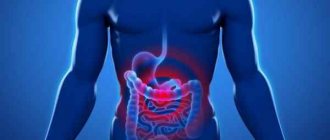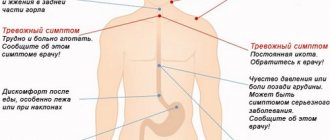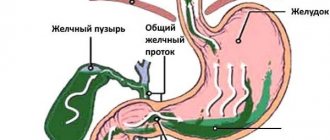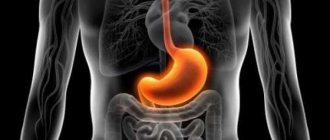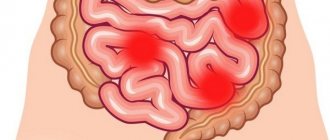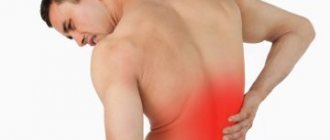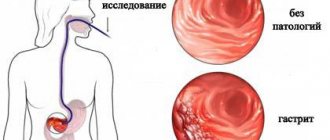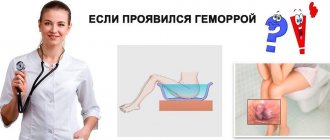Stomach pain is pain in the area above the navel, in the 4th intercostal space on the left, which is also called the epigastric region. Typically, a person experiencing severe cramping pain in the abdomen cannot stand straight because... As a result of spasm, the abdominal muscles reflexively contract, forcing the patient to tilt the body forward.
Gastralgia – pain in the stomach – is a symptom indicating organic pathologies or disturbances in the functioning of this organ, as well as other organs of the digestive system. Severe or moderate cramping pain in the stomach appears as a result of contractions of the smooth muscles of the stomach, causing a sharp spasm. The intensity of pain also depends on the strength of the contractions. Depending on the etiology, the nature and severity of pain can vary - from mild discomfort to painful shock, which requires immediate hospitalization.
Causes of cramping pain
Any pain in the internal organs signals pathologies or disturbances in their functioning. The causes of spasmodic pain in the stomach area are organic and functional.
Organic causes are various pathologies of the stomach and gastrointestinal tract, which occur most often in older people (for example, a stomach ulcer or inflammation of the mucous membrane of this organ).
Functional causes are processes not directly related to damage to the stomach and internal organs.
These include:
- neuralgia, stress
- allergic reactions;
- intoxication;
- injuries, abdominal bruises.
Functional causes of cramping pain in the stomach most often occur in people of relatively young age (up to 40 years) and are caused by various autonomic disorders and disruptions in nervous activity.
Main causes of pain associated with functional disorders
Neuralgic
Stomach cramps often occur in people exposed to stress and under prolonged nervous tension. Frequent overwork in combination with irregular nutrition (especially with a predominance of dry food, fast food, snacks) is considered by gastroenterologists as one of the main functional causes of cramping pain in the epigastric region.
Allergic reactions
In people with a sensitive immune system, painful cramping sensations in the stomach area occur as a result of food allergies, intolerance to a certain group of foods, or indigestion. Acute pain accompanied by cramping often occurs after consuming dairy products in the absence of enzymes that help the body digest lactose. Eating commonly known allergenic foods (peanuts, strawberries, citrus fruits, honey) can also cause stomach cramps and be accompanied by diarrhea and vomiting.
Intoxication
Alcohol overdose, as well as exceeding the dose of certain medications, also cause functional cramping pain in the stomach. The occurrence of this type of pain indicates severe intoxication of the body, in which a person urgently needs medical help (gastric lavage and administration of antidotes), otherwise death is possible. Food poisoning also refers to intoxication and is accompanied by vomiting and diarrhea. Most often, poisoning is caused by eating low-quality animal products (fish, meat), stale confectionery, etc.
Abdominal injuries
Pain and cramps in the upper abdomen resulting from trauma in this area (blunt object, fall on the stomach) should not be ignored. In combination with the so-called acute abdomen (severe tension in the abdominal wall muscles), abdominal spasms may indicate rupture of internal organs and bleeding, which requires immediate hospitalization.
A common feature of functional pain in the stomach is that it goes away automatically after the external cause is eliminated. Proper treatment of the nervous system, gastric lavage, timely administration of antihistamines, vomiting and bowel movements in 99% of cases lead to the disappearance of functional gastric pain.
Stomach diseases that cause cramping pain
Organic causes of spasmodic stomach pain are various diseases and organ lesions that require treatment. The most common stomach diseases that cause characteristic pain syndrome:
- gastritis
- peptic ulcer
Chronic diseases of the stomach are usually accompanied by periodic cramping pain, which, when taking medications, is relieved until the next exacerbation.
Gastritis
Gastritis of various etiologies is the most common cause of cramping pain in the epigastrium. This is an inflammatory process of the gastric mucosa, which is accompanied by heaviness in the stomach, heartburn, sour belching, nausea and other symptoms of dyspepsia.
Ulcerative process of the stomach and duodenum
Stomach ulcer and its symptoms
An ulcer is a pathology that occurs against the background of progressive gastritis and is quite dangerous, as it can provoke the formation of tumors. If an ulcer is detected, treatment should be started immediately, preferably in a hospital. It is cramping pain that is the main symptom of ulcers on the mucous membrane; it literally immobilizes a person and is manifested by symptoms that are concomitant and characteristic of many other gastrointestinal pathologies.
In addition, a stomach ulcer, in which cramping pain becomes more frequent, can occur against the background of cholelithiasis, cholecystitis, and appendicitis. Ulcerative processes can also occur on the duodenal mucosa. However, in this case, the pathology is most often chronic and is characterized by certain factors of its occurrence. This can be either an infectious lesion or poisoning with alkaline acids.
If you have a genetic predisposition to diseases of the gastrointestinal tract, you should prevent ulcers every year and lead a healthy lifestyle. Statistics show that children whose parents had an ulcer are susceptible to these manifestations in approximately 45% of cases.
Important!
Heartburn, bitterness and a lump in the throat always indicate inflammatory processes in the stomach. If they are accompanied by vomiting, which does not bring relief, you should call an ambulance, as dehydration is possible in the near future.
First aid for cramping abdominal pain
Any discomfort in the stomach always appears as a result of functional disorders in the functioning of the organ. To help him cope with the consequences of poor nutrition, it is necessary to exclude fatty, fried foods, fresh baked goods and white bread, alcoholic drinks and strong coffee. You should also limit spices and salt, which irritate the mucous membranes.
What to do if you have severe abdominal pain?
- It is necessary to provide rest to the patient, place him in a comfortable position (on his back, on his side).
- Interview the patient to determine the possible cause of the pain (for example, a person may suffer from a chronic stomach ulcer, gastritis).
- In case of severe pain, give an antispasmodic drug (No-Shpa, Drotaverine).
- In case of loss of consciousness, it is necessary to place the patient on his side to prevent vomit from entering the respiratory tract.
- If there is no pulse or breathing, begin artificial ventilation and cardiac massage.
- Call an ambulance.
What should you not do if you have severe abdominal pain?
- leave a person unattended;
- give painkillers (Aspirin and other acid-containing substances);
- give a person something to drink and eat;
- give an enema;
- give laxatives;
- put a heating pad on your stomach.
To prevent stomach pain, it is recommended to follow a healthy diet that includes a sufficient amount of natural fiber (vegetables, fruits, cereals). It is better to give up alcohol and smoking, monitor your body weight, and do not overuse sweets, confectionery, carbonated drinks, chips and other so-called. garbage food. It is better to completely exclude fast food, because... The abundance of trans fats in hamburgers, sausages, and hot dogs not only leads to digestive disorders. Trans fats cause serious harm to the body, causing blockage of blood vessels and the appearance of atherosclerotic plaques, which cause heart attacks and strokes in adulthood and old age.
Folk remedies for stomach pain
Chronic gastrointestinal diseases, accompanied by periodic cramping pain, can be treated with folk remedies. Often used for stomach problems:
- flax seeds - a decoction of seeds has excellent enveloping properties, which are good for gastritis and peptic ulcers (for the decoction, take 1 tablespoon of seeds per 1 glass of boiling water, taken 3-4 times a day before meals);
- cumin or dill - good for colic (1 tablespoon of dry matter is brewed with a glass of boiling water, taken regardless of food when pain occurs)
- dandelion syrup – normalizes acidity (use 1 tbsp per 100 ml of warm water, regardless of meals).
A warm heating pad, which should be applied to the abdomen in the area of pain, relieves pain well.
A warm heating pad is strictly prohibited if severe, sharp and cutting cramping pain occurs. If you have other dangerous symptoms (fever, diarrhea, vomiting), you should also stop using the heating pad and call a doctor.
Symptoms
The nature of the clinical picture, as noted above, will depend on the underlying factor. The collective symptomatic complex, if the etiology is a gastroenterological disease, will include the following:
- a feeling of heaviness in the stomach, fullness even with a minimal amount of food consumed;
- nausea and vomiting - these signs can appear immediately after eating food or regardless of the diet;
- increased flatulence, rumbling in the stomach;
- heartburn;
- bad taste in the mouth, belching with unpleasant odor or air;
- white coating on the tongue;
- violation of the frequency of bowel movements;
- the consistency of stool changes, there may even be admixtures of blood and mucus;
- general weakness, malaise;
- low-grade body temperature;
- pale skin, increased sweating.
In women, if the cause of such a symptom is not a gastroenterological disease, the clinical picture may include the following:
- nagging pain in the lower abdomen, which can radiate to the perineum;
- increased body temperature;
- bloody uterine discharge, but outside the menstrual cycle;
- pale skin, increasing weakness;
- dizziness;
- frequent urination, but of a non-productive nature;
- a state close to loss of consciousness.
The presence of such a clinical picture, especially if the woman is pregnant, requires immediate medical attention, since there is a threat to life.
In what cases should you call an ambulance?
If you experience cramping abdominal pain, which is accompanied by a number of dangerous symptoms, you should immediately call a doctor. These symptoms include:
- an increase in temperature to 39°C or higher with diarrhea (especially with bloody discharge in the stool) - this may be dysentery;
- “acute abdomen”, in which the abdominal muscles are painfully tense and hard to the touch - this may be a sign of intestinal rupture or perforation of the stomach wall as a result of injury, internal bleeding and other dangerous phenomena;
- severe bloating accompanied by constipation and vomiting is a sign of intestinal obstruction;
- unbearable “dagger” pain in the abdomen and loss of consciousness are a sign of perforation of the stomach wall.
Any pain in the abdominal area should not be ignored. Both men and women should monitor the functioning of the gastrointestinal tract in order to detect in time the onset of the development of various diseases and disorders.
Painful sensations in women
Pain in the lower abdomen can affect both men and women equally. But experts say that the female body is more susceptible to the development of unpleasant symptoms. This is due to their unique structure.
Pain during miscarriage
Cramping pain in the lower abdomen in women can occur during the development of spontaneous miscarriage or abortion. When a cramping syndrome appears, painful sensations radiate to the lumbar and sacral region. In addition to all this, the woman has bloody discharge from the vagina. With such symptoms, it is necessary to urgently call an ambulance.
If you leave everything to chance, serious complications may develop. The group of adverse consequences includes large blood loss, the development of anemia, acute endometritis, purulent salpingoophoritis, peritonitis and blood poisoning.
Painful sensations during ectopic pregnancy
A woman may experience pain in her lower abdomen when an ectopic pregnancy occurs.
This process is no different in symptoms from a normal pregnancy. The patient has a delay in menstruation, swelling and tenderness of the mammary glands, nausea and two lines on the test. Pathology can only be determined by ultrasound. You can suspect an ectopic pregnancy by cramping pain and bleeding. When such symptoms appear, there is no time to waste, otherwise the woman may lose not only the tube to which the fetus is attached, but also her life.
Development of myomatous node
Pain in the form of contractions may occur during the birth of a myomatous node. This process is understood as a tumor-like formation that has a small stalk. They leave the uterine cavity and enter the cervix, where they remain.
You can suspect a myomatous node based on the following symptoms:
- menstruation becomes painful and heavy;
- periodically there are nagging pains and discomfort;
- the functionality of the bladder is impaired. This phenomenon is characterized by frequent urination, a feeling of incomplete emptying;
- constipation appears.
Often this pathology does not immediately make itself felt. The disease can be detected at the initial stage if you regularly see a gynecologist.
The risk group includes those patients who:
- have never given birth before the age of 30;
- are obese;
- have a hereditary predisposition to fibroids;
- suffer from hormonal disorders;
- have an immunodeficiency state.
It is possible to cure a benign disease at an early stage. But the danger of a myomatous node is that it can develop into oncology at any time.
Treatment
Therapy will be aimed at eliminating the underlying cause.
Conservative therapy may be based on the following:
- taking medications;
- diet;
- normalization of the daily routine, implementation of general recommendations.
Surgical intervention is not excluded, depending on the diagnosis.
Symptomatic treatment may be based on drugs such as:
- antispasmodics;
- painkillers;
- intestinal antiseptics;
- antacids;
- proton pump inhibitors;
- prokinetics;
- antibiotics.
All medications prescribed by a doctor must be taken according to the regimen prescribed by him.
Provided that therapy is started promptly and correctly, complications can be avoided. But it is necessary to take into account the severity of the underlying factor.
As for prevention, there are no specific recommendations here. It is advisable to adhere to a proper diet and lead a healthy lifestyle. Self-medication is not recommended.
Pain of any location indicates that the body is signaling some kind of problem. Pain in the abdominal area in medicine is called abdominal pain syndrome. These sensations are subjective and appear when a signal enters the central nervous system from a diseased organ. Not all organs react to stimuli in the same way. Organs located in the peritoneal area do not react as strongly as, for example, the skin.
Diagnostics
If any pain occurs in the area of the stomach, hypochondrium, or abdomen, it is necessary to determine its cause.
For this purpose certain events are carried out. For women of reproductive age, pregnancy is first excluded. A general blood and urine test is required. Inflammation, in most cases, will show leukocytosis. Ultrasound of the peritoneal organs can detect ectopic pregnancy, aortic aneurysm, ascites and some other pathologies. Computed tomography helps to identify appendicitis, nephrolithiasis, intestinal obstruction, and mesenteric ischemia. Violations of the integrity of hollow organs, their perforation, and obstruction can be detected using plain radiography. In order to exclude myocardial ischemia, an ECG is performed.
If, after a thorough examination, the cause of the pain cannot be identified, capsule endoscopy is recommended. This method allows you to examine the small intestine, which is quite difficult to examine with standard methods due to its difficult accessibility, and to identify tumor processes, ulcerations, Crohn's disease and some others.
Stomach pain is pain in the area above the navel, in the 4th intercostal space on the left, which is also called the epigastric region. Typically, a person experiencing severe cramping pain in the abdomen cannot stand straight because... As a result of spasm, the abdominal muscles reflexively contract, forcing the patient to tilt the body forward.
Gastralgia – pain in the stomach – is a symptom indicating organic pathologies or disturbances in the functioning of this organ, as well as other organs of the digestive system. Severe or moderate cramping pain in the stomach appears as a result of contractions of the smooth muscles of the stomach, causing a sharp spasm. The intensity of pain also depends on the strength of the contractions. Depending on the etiology, the nature and severity of pain can vary - from mild discomfort to painful shock, which requires immediate hospitalization.
